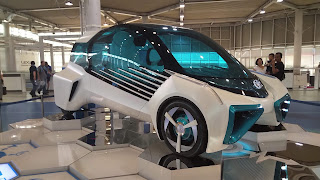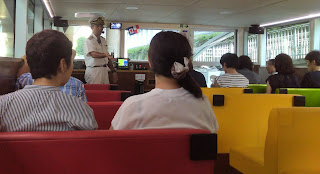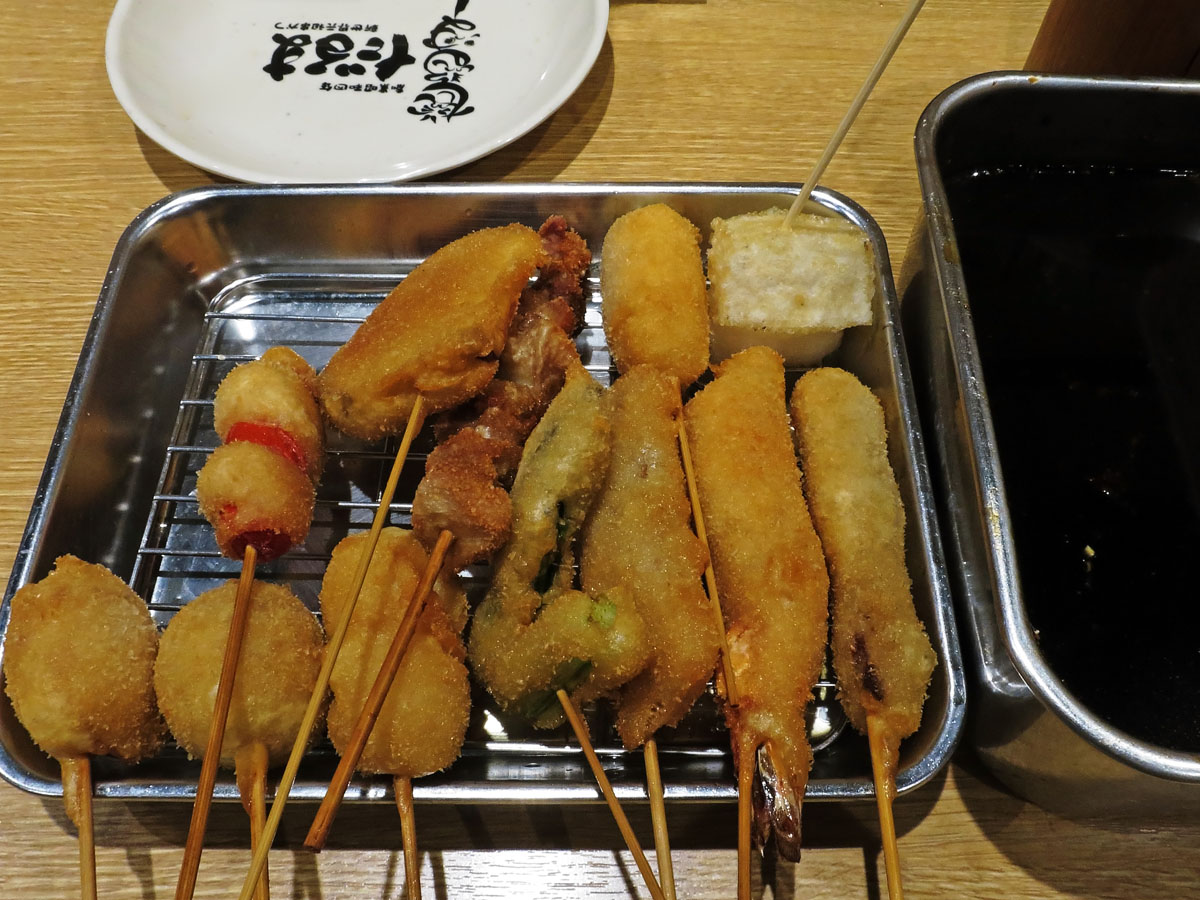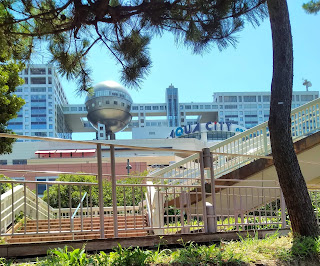 |
| Skyliner train at its Narita terminus |
There's a choice of transportation to reach the centre of Tokyo from Narita airport. On our first visit seven years ago we'd been met by a Japanese gentleman who helped us buy tickets for a direct "Limousine bus" ride to the Tokyo City Air Terminal near our hotel. This time, the TCAT was not so convenient because we'd have needed to buy a separate subway ticket from to this year's hotel. We'd had some advice from a citizen of Tokyo who told us that our best option was to take the fast,
Skyliner train to Ueno, then change to the Ginza line. Taking the
Narita Express train to Tokyo's central station and going the rest of the way on foot would have worked too, but the walking route at the end wouldn't have been straightforward.
The
Skyliner is comfortable and fast, although you can't see much out of the window beyond the barrier fence that lines its tracks. Before we were allowed to board the train at the airport we had to wait while it was rapidly and efficiently cleaned. Seat reservations are compulsory. My only complaint is that foreign travellers ought to be warned the ticket office deals with cash only, not credit cards. We were encouraged to buy "Special Discount" return tickets that included full use of the city's underground train system, valid for 24 hours after our arrival. It was a shame we were too tired to take full advantage of this deal.

The subway trains in Tokyo are worth using, for the cultural experience. I was surprised at how full they were at 9:30 - 10 a.m. and around 7 p.m.; Tokyo office workers start and finish work later than in the countries I'm used to, so these are the rush hours. Most trains are air conditioned, which is just as well, but I often noticed people fanning themselves, either with electrical or traditional fans. Not so many people wear face masks in August as in February. The predominately solitary passengers use their smartphones to avoid too much eye contact. Children are brought up to keep quiet and still in the trains. At each stop, electronic signs indicate where you are, Japanese and English displays alternating, showing a list of possible connections and which side of the train to step from. The more up-to-date platforms have barriers with automatic gates that line up with the train doors, preventing suicide attempts. The trains are long and frequent. Stations are long, too, some requiring a good half kilometre's walk underground, and generously supplied with shops, eateries (numerous French bakeries / coffee shops associated with the commercial towers above street level), information centres and washrooms. Their passages are spotlessly clean. At the stairwells of our local station, Mitsukoshimae, lights in changing colours enhance the brick walls. I have read that the blue lights are another suicide preventative, that has proven effective in this nervy city.


Travel by road is another story. Chris rode a short distance in a posh limousine to one of his meetings. We saw regular taxis slipping down side streets, but didn't make use of one. An eye-catching vehicle was the little one-person EV we passed on our first morning in Tokyo, ready for hire on a street near the Imperial Palace; we also found one of these at Toyota's MegaWeb showplace on Odaiba island, where I sat in it. The driver's seat is the only seat; someone my size just fits, but it would be too small for Chris.
 |
| The Concept Car |
The
MegaWeb theme park, fun for the whole family, is really a glorified car showroom, a clever idea of Toyota's. It features one of their
Concept Cars, a futuristic, "smart" vehicle that could be fuelled by hydrogen. The site also has a race track would-be race drivers can try out, and an area where able-bodied kids can sit in wheelchairs to play basketball, an allusion to the fact that Toyota is
sponsoring the 2020 Paralympics.
 |
| I'm not sure where these cars come from, being enjoyed by young tourists |
Speaking of the MegaWeb reminds me that this was located beside Tokyo's 115 m high
Giant Sky Wheel, another vehicle we rode on, in a very small cabin that wobbled. It wasn't air-conditioned on that very hot day (Sunday, August 11th) and it did not feel at all safe up there, but no harm done. The choice was between that cabin and a larger one with a glass floor (no thanks!) --- more expensive, cooler inside. We were snapped by an opportunistic photographer at the entrance.
 |
| Skywheel seen from below |
 |
| The hatless girl noticing a Fisheries Inspection ship |
We couldn't leave Tokyo without taking a boat tour. We rode on a smallish river boat based at the
Nihonbashi (Edo Bridge in the old days) the spot where Tokyo's zero milestone was set in the 17th century, now below concrete pillars supporting the overhead motorway. The authorities have done their best to beautify the underside of the motorway by having a section of it painted glossy white and by affixing lights that reflect in the paint after dark. We took the boat tour after lunch on a sunny, windy day. Straw sunhats were provided for passengers, but before we'd gone very far, one of the girls on the front deck lost hers overboard in a gust; it sank in the Nihonbashi River. We'd walked beside the wider Sumida River that morning and seen a pair of fire-brigade boats doing manoeuvres on it. Now we emerged from the canal further downstream on that river in choppy conditions that made for an exhilarating ride. We bounced along under several big bridges and past several important looking boats.
 |
| Firemen working on the Sumida River |
 |
| Tokyo docklands , as seen from the Big Wheel |
 |
| Bridge at a river confluence in Tokyo |
 |
| On the river boat the Captain gave the commentary (in Japanese) |
 |
| Out in Tokyo Bay |
For me, the most fun in Tokyo can be had by riding on the
Yurikamome Line train across the high Rainbow [suspension] Bridge crossing the mouth of the Sumida River into the docklands on the Odaiba island, the reclaimed, very modern part of town where my daughter stayed for a conference once, at the
Grand Nikko Hotel. I went by myself on a weekday then brought Chris back for a more crowded experience the following Sunday. The quieter time was better because I could sit at the front of the driverless train on that day. It isn't only children who enjoy this. A train ticket allowing unlimited rides is the best bet for this line; then you can get off and on again as often as you wish. As a matter of fact I have written
a blogpost about the experience before. On this trip I walked through the stations at Odaiba-kaihinkoen from which you can walk downhill to a beach, Daiba where a copy of the Statue of Liberty stands, the Tokyo International Cruise Terminal from which you can visit the Maritime Museum or what remains of it (after seven years they still say this ship-like building is being renovated), Aomi to visit the Mega Web, big wheel or "Venus Fort" (this being a fancy shopping mall in an architectural style akin to the Galleria Vittorio in Milan, not a sex shop as Chris assumed from its name), Kokusai-tenjijo-seimon where the Convention Centre is (the Tokyo Big Sight), Toyosu (the terminus, a residential area), and at Shimbashi of course, the first and last stop on the line.



















































